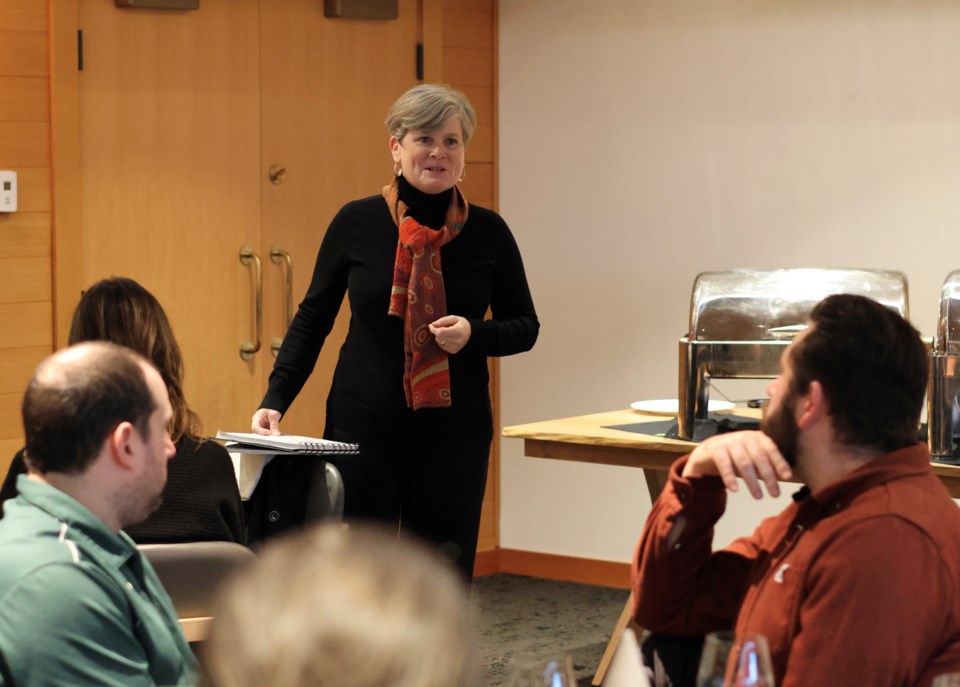It was only fitting that the former Mayor of Tofino gave her first public speech as sa国际传媒’s Health Minister during a Tofino-Long Beach Chamber of Commerce luncheon on Dec. 17 at the Wickaninnish Inn.
With local physician and Tofino General Hospital chief of staff Dr. Carrie Marshall by her side, Osborne shared how living in a rural community like Tofino in Tla-o-qui-aht First Nation’s traditional territory helped her land what is arguably the most challenging ministry appointment.
“When the premier first told me, I was very surprised,” Osborne told the room of Tofino business owners. “I don’t have a health-care background, in terms of my life experience or education, but the premier did tell me he felt it was really important to have someone from a rural community step into this role for a while because we know that health-care delivery touches every single person, every single day.”
“People living in rural, remote and Indigenous communities have more barriers to accessing health care in an equitable way and it’s something that’s very near and dear to my heart. All rural issues have been and it’s something that I’ve always been really proud of to take that voice into cabinet,” said Osborne, who was the mayor of the small coastal town during the first six months of the pandemic.
Osborne moved to Tofino over 20 years ago to work as a biologist for the Nuu-chah-nulth Tribal Council (NTC). She expressed her gratitude for her time working with Nuu-chah-nulth communities because it gave her a deeper understanding of the barriers that people face – and the racism.
In 2020, sa国际传媒’s Minister of Health Adrian Dix established an independent investigation into systemic Indigenous-specific racism in health care in British Columbia. The investigation found extensive profiling of Indigenous patients based on stereotypes about addictions. It was also uncovered that this “widespread racism has long been known by many within the health-care system, including those in positions of authority, and is widely acknowledged by many who work in the system.”
The review team involved with the investigation published a report called In Plain Sight: Addressing Indigenous-specific Racism and Discrimination in sa国际传媒 Health Care, which offered a number of recommendations based on the findings.
Mandating training for Indigenous cultural safety in sa国际传媒’s health-care workers, improving how to handle complaints of racism and meaningfully integrating Indigenous practices and knowledge into the health-care system were noted as tools to change the current racist climate of sa国际传媒’s health-care setting.
Osborne acknowledged there is a lot of work to do.
“The goal is to eliminate anti-Indigenous racism in the health-care system,” said Osborne, adding she thought creating more culturally safe physical spaces at hospitals is important.
She lent the example of the Tofino General Hospital being gifted the Nuu-chah-nulth name S虒aah蹋yitsapaquwi艂”, (pronounced, shah yit sa pa qu wilth ), which translates to “A place where people go to get well.” S虒aah蹋yitsapaquwi艂 replaced the Nuu-chah-nulth word for hospital, “Taa蕯i艂 艂uuw虛as” (Ta/ilth/thloo/wus), which translates to “a place to go when you are sick.”
“It’s just turning our heads from a place where a hospital is a place where people are sick to a health-care system is a system of people and places to help people get well and stay well,” Osborne continued.
She told the Ha-shilth-sa her past work as a fisheries biologist and having a degree in biology and ecology taught her how to look at the big picture and the relationship between systems.
“The health-care system is just that. It’s a nested group of relationship and systems. It’s all connected. It’s more of a holistic view of looking at things, which seems so complementary to an Indigenous world view,” said Osborne.
The decision to bring the Ministry of Mental Health and Addictions back into the Ministry Health was taken, according to Osborne, because the toxic drug crisis is a health issue.
“I think a lot of the policy work that was done (by the independent ministry) and the work to reduce stigma and be able to talk openly about opioid use and drug and alcohol use in general was really important. But bringing the two ministries back together means we can be more efficient and expedient with decision making and really accelerate the development of a continuum of services,” said Osborne.
With a file from Carla Moss



